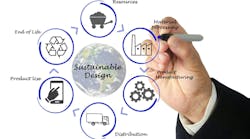Manufacturers: Act now to prepare for SEC climate disclosure rule
As the Earth’s temperature heats up, so too does debate about the SEC’s proposed climate-disclosure rule. Introduced in March 2022, the rule would require public companies to report data associated with climate-related risks and emissions, including their own emissions (Scope 1 and 2) and emissions that come from their supply chain (Scope 3). Challengers to the rule say the SEC has overstepped; supporters — including eco-conscious consumers — call it a win.
While the rule is expected to move forward (despite some likely legal challenges), companies aren’t waiting for it to be finalized. According to reporting by PwC and Workiva Inc., 70% of companies are proceeding with compliance now. Among them are many in the manufacturing industry, which accounts for approximately 20% of the global climate impact from human activities.
In light of the new rule, manufacturing companies must make strides in developing and selling environmentally sound products, and then estimate the impact of these in their climate reporting. Smart manufacturing technologies, such as some configure-price-quote (CPQ) solutions, can ease and streamline that process.
LCA: Measure your impact first
Before we get into CPQ’s role in climate reporting, it’s important to first introduce the established methodology for estimating environmental impact.
As its name implies, life cycle assessment (LCA), measures the environmental impact of goods, materials, processes or other quantifiable activity over its entire life cycle. Specifically, LCA measures the many inputs (such as water and energy) and outputs (such as emissions and waste products) that take place during the industrial process, technology or commodity. These precise measurements keep tabs on certain quantities like weight, mass or volume. From there, the LCA goes through a comprehensive process, including defining the goal and scope, analyzing inventory, assessing impact, reviewing and reporting.
It’s this last piece — reporting — that companies must focus on as stated in the SEC ruling. While this SEC rule addresses climate specifically (one of the three legs of sustainability), reporting will ultimately have a profound impact on how a company is judged in terms of overall sustainability.
LCA + CPQ
While LCA is a first step toward climate reporting for products over their life cycle, i.e. when they leave the manufacturer, stronger internal data from many businesses and regions must be combined into reports to meet audit criteria. (LCA systems with up-to-date data on impacts from manufacturing processes and materials extraction help here.) At the same time, manufacturers must also modify their sales models to remain competitive. The right CPQ solution supports both objectives.
CPQ solutions can help manufacturing companies configure clients’ needs for environmental sustainability into the best possible solutions, which might aid in cutting waste and increasing energy effectiveness. In combination with an LCA system, a CPQ makes climate reporting possible for the products that manufacturers put into market — including the impact of the supply chain. In addition, CPQs provide new ways for manufacturers to suggest environmentally sound product choices, making it easier to reduce environmental impact.
LCA integrated in CPQ solutions also eliminates manual entry, which decreases errors; they may assist businesses in locating and suggesting environmentally sound and energy-friendly goods to meet customer requests; and they can make pricing and bidding for greener solutions more efficient. Equally beneficial is making the measured impact visible to potential customers. To that end, a CPQ solution can help optimize bids to choose the configuration with the least environmental impact and inform the client of the savings realized.
CPQ, the circular economy and Industry 4.0
CPQ can also refine the environmental footprint calculations for the most important stage in a product’s life cycle — the use phase. When a manufacturing customer is building or configuring their product with a CPQ solution, they can add expected usage data based on earlier experiences. Calculations are then made in separate LCA software, imported back into the CPQ system and shown to the customer. The output is an orderable product with an estimated climate footprint expressed in carbon dioxide equivalents and an attached climate footprint report for climate reporting.
But, as the circular economy takes hold and Industry 4.0 becomes a reality, we can see more clearly how CPQ solutions can be applied for sustainability. For example, manufacturers could track energy use and water and chemicals at the processing line when a specific part is produced and add this information to other data points displayed in the CPQ. These data serve as the environmental impact data input for that specific part. In addition, if a manufacturer sells a refurbished product, rather than an entirely new one, CPQ will allow them to promote the environmental benefit of that product, helping customers find greener alternatives that align with their sustainability goals. Ultimately, by harnessing the power of CPQ in conjunction with the circular economy and Industry 4.0, manufacturers will be able to pave the way for a more circular future.
Repercussions — and benefits
The increased interest from the financial market in the climate impact of industry, due to the connected risks (and opportunities) and operational costs, is very much welcomed by the forward-looking companies that have for years invested in managing their climate impact. Part of their impact is due to the characteristics of the products they put on the market. The new SEC rules require transparency of the impact also outside of manufacturers normally manage — their own operations.
Financial penalties for non-compliance should be enough of an impetus to get companies on board with the new SEC rule, but the repercussions could extend beyond that. In today’s business climate, where curious consumers can do their own background checks with just a few clicks, the reputational risk is real. It’s important for manufacturing companies to keep this in mind and remember that their efforts to submit and report accurately and transparently have long-standing effects on their own reputations and creates competitive advantage.
If anything, the new SEC rule shines a bright light on emissions, forcing companies to invest in practices and processes that will create a more sustainable future for us all. Manufacturing companies that follow clear-cut methodologies and choose smart manufacturing technologies, including LCA systems and CPQ solutions, will be able to do their part in this endeavor, and satisfy their investors and consumers along the way.




